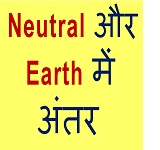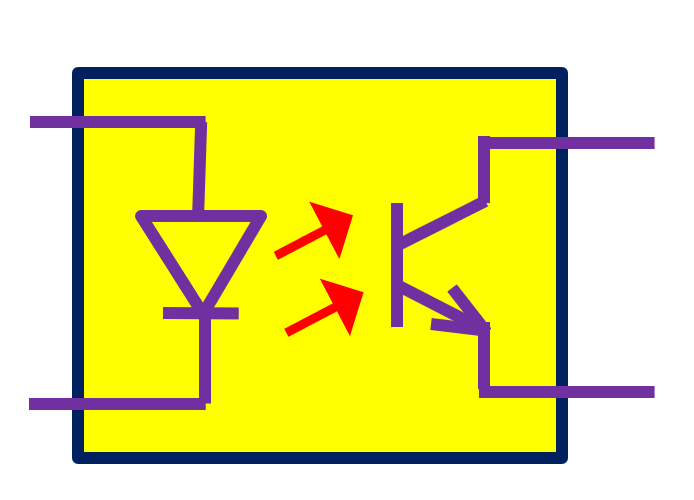I will explain in this post all about, what is wind power or energy. And how we generate it. And what are a wind farm and its problems?
What is wind power or wind energy?
Wind power or wind energy is a type of energy that is generated from the kinetic energy of moving air. Electricity generated from the moving wind is called wind power or wind energy.
Wind power is generated by converting the kinetic energy of the moving wind to electricity. We use a wind turbine generator for this purpose.

What is windmill
A windmill is a machine that converts the kinetic energy of the air into mechanical energy. This mechanical energy can be used to perform many other useful activities like grinding etc.
Difference between windmill and wind turbine
A windmill converts kinetic energy into mechanical energy, but wind turbines convert kinetic energy into electrical energy. However nowadays, many times we call wind turbines windmills also.
How does a wind turbine work to generate power or energy?
The wind turbine works: by first rotating the blades of the turbine using air pressure, then converting this spin of the blades into electrical energy.
The moving wind strikes the blade of the wind turbine. These blades look like helicopter blades. But they are in the vertical direction. Wind force makes these blades rotate. This rotation of the blade makes the rotor of the generator rotate.
Then the generator generates the electricity of the required voltage.
I saw in many places, where these blades rotate quite slowly (not like the speed of fan blades).
Afterward, a transformer changes the output voltage to the desired level.
Further, we connect the output of this transformer to the grid for synchronization.
Thus finally electrical grids distribute the power to the customer.
We can generate wind energy onshore and offshore both.
Wind energy is one of the renewable energy sources. It gives free and clean green power. It does not generate any pollution. We can save other types of energy using this method.
Asynchronous power generation
In an asynchronous generation, the turbine speed of rotation varies with the wind speed to get maximum power.
Block diagram of the windmill turbine system
Figure 1 shows one typical type of conceptual control function block diagram for wind power generators.
The wind turbine generates AC electricity. The electronics convert this AC into DC. Then DC is again converted to AC.
Further, this ac is connected to the grid after filters. Then the transformer increases the voltage level to the desired grid voltage level.
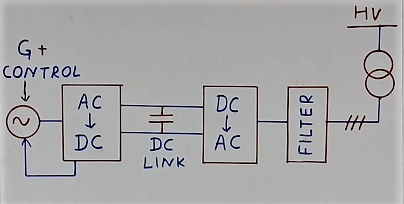
However, this block diagram may be different for different technologies. As technology is changing very fast, so is the concept.
What is the wind turbine power curve?
Figure 2 shows an example of the wind power curve with respect to wind speed for a 2MW turbine. Power output is maximum for wind speed from about 10 m/s to about 30 m/s.
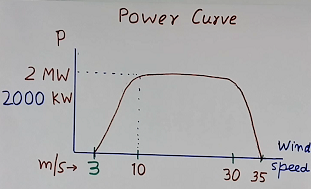
If the wind speed goes more than 35 m/s, then we apply the brakes to stop damage to the turbine. At very low wind speeds, very little or no power generates.
The above power curve may depend on the type of turbine and the rating of the turbine.
Requirements for windmills for wind power
We require the following to install the wind power generators
- Wind availability
- Low cost of land
- Power grid availability
- Road etc
The problems in wind power generation
The major problem in wind power generation is the availability of wind at the desired speed. If the wind speed is more, then the wind generator will damage, so we apply the brake. If the speed of the running air is not sufficient, then power will not generate.
Further, even high-speed wind also is not good. As it damages the generator. So we apply break during high wind speed. And no power will generate.
Then, the power so generated also has a very poor power factor. So, A power factor improvement device improves the power factor. However, the concept shown in figure 1 does not require a separate power factor controller. As this function may be built into the control itself.
As the wind is not available at desired speed always. So the generator will not work for a considerable time in a year. Due to this reason mainly, wind power generation is not economical. So in many cases, the government provides subsidies as per the rules to make it profitable.
We can install windmills on the hilltop, near the sea, inside agricultural land, or on non-fertilized or dry land. This makes the land cost less expensive.
What is a wind farm
As windmills are located in remote places. So the manufacturer installs a large number of generators in a single place. We call it a wind farm.
A wind farm is a group of a large number of wind power generators installed in a single place.
Subsequently, manufacturers sell the windmills to many buyers in small numbers.
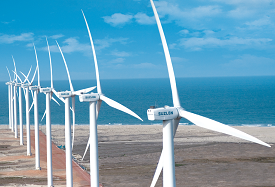
Windfarm may have more than 1000MW capacity. The Muppandal Wind Farm is onshore and has a 1500MW capacity. This has a very large number of will mill turbines or generators. They are sold to a very large number of customers.
Arrangement of windmills in a wind farm?
Figure 4 shows the connection of many turbines with the grid in the wind farm. They are all connected in parallel to the grid.
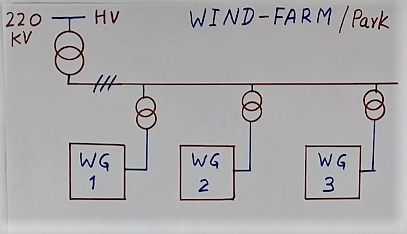
Cost concept of the windmill for wind power
The capital cost is a new windmill for generating wind power may be a few crores Rs. per MW based on the following factors
- Type of turbine
- Size or power rating
- Location
- Technology
Onshore, offshore, and maintenance of windmills
Onshore windmills are those windmills that are on the land.
Offshore windmills are those, which are in the sea (in the water) but not very far from the land.
Offshore-type windmills are expensive. But as wind availability is better in the sea, these types of windmills give more energy for longer periods of the year and remain off for a short time during any year.
How small investors can buy windmills on a wind farm?
Manufacturers of windmills ( or wind generators) install a very large number of mills in some areas depending on the availability of more wind, and also the low cost of the land. Then they will sell wind generators to many buyers in small quantities.
In this way, many investors will own the generators in the same place.
You can buy windmill generators sitting in any corner of India and buy generators operating in any other corner of India without even vising and seeing the equipment. The manufacturer will take care of everything like
- Taking various approvals
- Installing wind generators machines
- Connecting it to the grid
- Selling power to electricity board or power grid etc
- Maintaining the equipment
If you have the money, you can just invest in windmills by sitting at home and get a return every year. You can also get electricity at the place of your choice in place of money. No need to visit remote places.
I hope that you enjoyed this article on “What is wind energy and how it is generated“
Knowledge from experience – wind power
I have visited many wind farms located in Andhra Pradesh, Karnataka, Tamilnadu, and Kerala in India. As we supplied some equipment (power factor improvement) for the windmill of mostly small ratings.
The power electronics type panels supplied by us were located below the tower. The mounting of panels was either inside a round cemented tower at the ground or in a cabin next to the tower.
They are at most located in a very remote place. Many times on the hills. It is difficult to reach there due to not proper road.
Further, the blades of the wind turbine rotate very slowly. A few windmills generating wind power were found to be not working for want of repair or maintenance shut down.
The company (supplier) gets all the data on windmills working in the office located in the city live.
Further, you can read – AC or DC, which is more dangerous.
Also, read what is SMPS electrical transformer
Further, read What is an optocoupler
Keep learning and read Why power factor improvement
If you like video articles then watch about windmill
If you like this post then subscribe to my YouTube channel, G K Agrawal
About the author – G K Agrawal B.Sc and B.Tech (from HBTU Kanpur), Retd. Sr DGM Design (BHEL), the inventor of patents, has lifelong industry experience in the electrical and electronics design field of R&D. He worked for BHEL. He shares his experience and knowledge on blogs and YouTube. Read the profile here.

